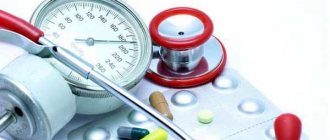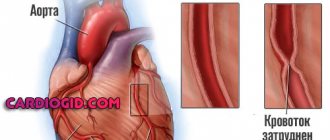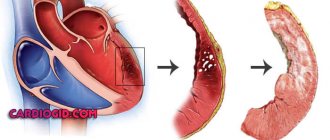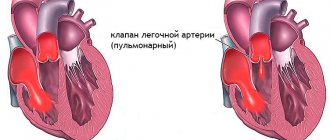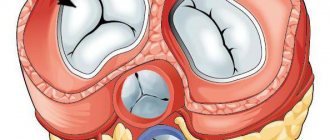Hypertension is the most common disease of the heart and blood vessels, affecting at least a third of the world's population. In recent years, there has been a clear trend towards rejuvenation of this pathology; even very young people are forced to constantly take medications and treat hypertension of stage 2, and sometimes higher. The insidiousness of this disease is that many patients do not feel any symptoms at all, and the tragic outcome sometimes seems unpredictable.
Blood pressure (BP) is a variable value; it can fluctuate many times during the day in one direction or another. Hypertension is said to occur when there is a stable, long-term increase in blood pressure above normal values. Hypertension is a chronic pathological condition characterized by arterial hypertension syndrome of varying severity. What is stage 2 hypertension, what are its risks, how to live with this diagnosis and how to treat it - more about this.
general information
Blood pressure is one of the main indicators of cardiac activity, which is determined by two quantities:
- systolic value (upper pressure) - occurs during systole (contraction) of the left ventricular myocardium and the release of a portion of blood into the aorta;
- diastolic value (lower pressure) - depends on the tone of the vascular wall in the diastole (relaxation) phase of the ventricle.
The value of blood pressure is influenced by such indicators as:
- the volume of blood circulating in the vessels - as the volume of blood volume increases, the pressure increases and vice versa;
- condition of the vessels - the smaller the diameter or the more narrowed the lumen, the greater the resistance and the higher the pressure;
- heart rate - the faster the heart works, the more blood is pumped per unit time and the higher the blood pressure.
The norm for an adult is considered to be values that range from 100/60 to 139/89 mm Hg. Art. During the day, blood pressure values change many times; jumps upward can occur after physical activity, with excitement, after a cup of coffee or a cigarette. Such temporary changes have nothing to do with hypertension.
A single detection of elevated blood pressure cannot indicate that a person has this diagnosis. The setting and circumstances in which the procedure is carried out must be taken into account. To confirm the presence of a disease in a patient, for example, stage 2 hypertension, it is necessary to carry out regular measurements of blood pressure over time. Based on a series of consistently elevated numbers, a preliminary conclusion can be made; the final diagnosis is made after examination and clarification of the cause of the development of the pathology.
How to treat heart pathology
Therapy aimed at relieving pain and accompanying signs of discomfort is prescribed for severe symptoms. If required, the doctor draws up a treatment regimen.
| Medications | How do medications work? |
| Sedative medications | Relieves signs of anxiety, helps improve sleep, increases stress resistance |
| Adrenergic blockers | Blocks the release of adrenaline, and in case of 2nd degree cardiac pathology helps to normalize heart rhythm |
| Group of anticoagulants | To thin the blood and restore metabolic processes, protect against thrombosis |
| Nootropic drugs, antidepressants | Prescribed against symptoms of vegetative-vascular dystonia, the influence of depressive situations |
| Vitamin and mineral complexes | Improves myocardial metabolism, enriching the heart muscle with potassium and magnesium ions, increasing vascular tone |
If the symptoms of bulging valve leaflets are weak or absent altogether, treatment for grade 2 mitral valve prolapse is not carried out. According to the recommendation of the attending physician, it is sufficient to adhere to the regime of wakefulness and sleep, proper nutrition. Patients are not prescribed special therapy; having prolapse of the 2nd degree, people can even play sports. Thanks to the exercises, it is possible to keep the condition of the mitral apparatus under control, slow down the progress of protrusion, and strengthen the heart.
For minor manifestations of the disease, herbal medicines are sufficient. Such folk remedies as hawthorn fruits, valerian and motherwort herbs, and St. John's wort quite successfully cope with signs of heart pain and nervous disorders.
Valvular anomaly and the army
Parents of teenagers who have reached conscription age are concerned about whether those with grade 2 prolapse will be accepted into the army. If mitral regurgitation is of a moderate type, prolapse is not included in the group of contraindications for military service. The amount of prolapse (deflection) of the valve leaflets is less dangerous than the severity of reverse blood flow.
However, when more profound disorders are combined with other serious disruptions of cardiac function, the patient is exempt from military duty. Although MVP is not considered a life-threatening condition, it is important to monitor your heart function by seeing a cardiologist based on their recommendations.
Threat of complications
Despite the fact that prolapse at stage 2 without any special symptoms is not considered a dangerous health problem, the pathology of the mitral leaflets should be monitored. Without treatment of even mild symptoms of impaired functioning of the valve apparatus, a favorable prognosis may result in a worsening of the condition, and heart failure will have to be corrected surgically.
Did you like the article? Save it!
Still have questions? Ask them in the comments! Cardiologist Mariam Harutyunyan will answer them.
Ivan Grekhov
Graduated from the Ural State Medical University with a degree in General Medicine. General practitioner
Classification
Depending on the degree of increase in blood pressure, the following types of hypertension are distinguished:
- Arterial hypertension 1st degree – considered mild, characterized by a persistent increase in blood pressure within the range of 140/90 – 159/99 mm Hg. Art.
- Arterial hypertension 2 degrees - moderate hypertension from 160/100 to 179/109 mm Hg. Art.
- Arterial hypertension 3rd degree - a severe disease with hypertension more than 180/110 mm Hg. Art.
The value of blood pressure is the most important, but not the only factor for determining the severity of arterial hypertension and patient management tactics. In practice, great importance is attached to the assessment of overall cardiovascular risk; its degree also depends on the following indicators:
- the presence of concomitant unfavorable factors - any type of diabetes mellitus, high levels of total cholesterol in the blood (more than 6.4 mmol/l), long history of smoking, heredity with aggravated heart and vascular diseases, age (males over 56 years old, females older 66 years old);
- symptoms of damage to organs that are targets for hypertension - heart valves and muscles, vascular walls, renal parenchyma, brain matter, eyes.
The division into stages of hypertension is carried out on the basis of existing signs of pathology in these organs:
- In stage 1 hypertension, objective symptoms of target organ damage are not detected.
- Stage 2 hypertension has at least one of these signs. For example, detection of left ventricular hypertrophy on an ECG or echocardiography, narrowing of the fundus vessels, cholesterol plaques in the aorta or coronary arteries on X-ray or ultrasound, increased levels of protein fractions in the urine.
- In stage 3 hypertension, there are severe concomitant clinical conditions, for example, myocardial infarction, aortic aneurysm dissection, stroke, and chronic kidney failure.
There are 4 levels of risk:
- Insignificant risk – there is only an increase in normal blood pressure values.
- Moderate risk – there are 1-2 unfavorable factors.
- High risk – there are 3 or more unfavorable factors, or experience as a diabetic, or signs of target organ damage.
- A very high risk is the presence of concomitant severe pathologies with a pronounced clinical picture.
Etiology
In 90 out of 100 patients, the cause of the constant increase in pressure remains unknown - this is primary (essential) hypertension, which is considered as an independent pathology. In other cases, there is some kind of premorbid background (another disease), one of the manifestations of which is high blood pressure - this is symptomatic or secondary hypertension. Depending on the etiology, it is divided into four types.
- Hypertension of renal origin develops against the background of congenital anomalies of the genitourinary system (hydronephrotic transformation, polycystic disease) or with severe acquired diseases (various forms of glomerulonephritis, pyelonephritis, chronic renal failure). Characteristic is stable hypertension of at least the second degree, high diastolic pressure numbers.
- Endocrine hypertension is a mandatory symptom in thyrotoxicosis, Itsenko-Cushing's disease, pheochromocytoma, obesity, etc.
- Hemodynamic hypertension occurs due to disturbances in normal blood flow, which is a constant companion to many heart diseases (congenital and acquired malformations, atherosclerosis, hypertrophic cardiomyopathy). A significant increase in systolic pressure is characteristic.
- Neurogenic hypertension - in the medical history of such patients there are indications of severe traumatic brain injury, acute cerebrovascular accident, encephalitis, brain tumors, etc. This type of hypertension is characterized by attacks of increased blood pressure, which are combined with dizziness, headaches, neuropsychiatric disorders.
Reasons for the development of the defect
Mitral valve prolapse can occur as an independent disease or be a consequence of other cardiac pathologies. The exact reasons for the development of a birth defect have not yet been established. But experts suggest that MVP in this case develops due to abnormalities of the connective tissue of the valve structure of a hereditary nature. The most common among them is dysplasia. Exposure of the fetus to toxic substances in the womb is another possible cause.
A number of diseases and conditions can trigger the development of acquired MVP, including:
- coronary heart disease;
- cardiomyopathy;
- inflammation of the heart muscle - myocarditis;
- thyroid disease (thyrotoxicosis);
- autoimmune diseases (systemic lupus erythematosus);
- genetic pathology – osteogenesis imperfecta;
- acute rheumatism;
- chest injury.
Attention! If the closest relatives of a pregnant woman have suffered or are suffering from diseases of the cardiovascular system, this should be reported to the attending physician.
Clinical manifestations
With stage 2 hypertension, symptoms may be completely absent or mild for a certain period of time. Complaints appear in the presence of target organ damage or the development of concomitant clinical conditions.
The higher the stage of hypertension and the longer the duration of the disease, the stronger the damage to target organs and the brighter the clinical manifestations.
There are several main syndromes (complexes of symptoms) that are characteristic of stage 2 hypertension:
- Cardiac – discomfort and pain in the chest in the projection of the heart, disturbances in the frequency and rhythm of heart contractions, a feeling of lack of air, shortness of breath. Sometimes hypertensive crises (sudden surges in pressure) can occur, which last up to several hours.
- Cerebrovascular syndrome - attacks of dizziness, fog in the eyes, pain in the occipital region, nausea, noise in the head, weakness, increased fatigue.
- Nephrotic (renal) syndrome - swelling on the face in the morning, changes in quantitative and qualitative indicators in urine tests.
Second degree hypertension can occur in a patient with any stage of hypertension and a different risk of developing complications. For example: Stage 2 hypertension, risk 2 means that a person’s blood pressure steadily rises to a level of 160/100 – 179/109 mm Hg. Art. with a moderate risk of complications. Adverse consequences in case of further progression of the disease may include:
- pronounced hypertrophy of the walls of the left ventricle;
- IHD – unstable angina, acute infarction;
- acute disturbance of cerebral circulation - ischemic or hemorrhagic form of stroke;
- encephalopathy (damage to brain structures due to death of nerve cells);
- retinal angiopathy (change in the normal vascular pattern in the fundus) up to loss of vision;
- rupture of aortic aneurysm;
- renal failure - increased creatinine levels in the blood with reduced glomerular filtration and high protein content in the urine;
- development of chronic heart failure.
With stage 2 hypertension, risk 3, a person already has clinical signs of target organ damage; the same diagnosis is given to patients suffering from diabetes mellitus. At this stage, the disease is more difficult to treat and reluctantly gives up its positions.
If treatment is carried out untimely or incorrectly, then stage 2 hypertension with risk 4 may develop. This means that the patient has severe concomitant pathological conditions (heart attack, stroke, aortic dissection or others) with a pressure level not exceeding 179 mm Hg. Art. In this case, it is almost impossible to regain lost health.
Methods of prevention
It is impossible to avoid the appearance of congenital MVP. Typically, pathology occurs in the fetus during intrauterine growth. But you can reduce the risk of developing grade 2 and 3 MVP by following simple prevention rules:
- to live an active lifestyle;
- maintain a sleep and rest schedule;
- adhere to the principles of proper nutrition;
- promptly treat infectious diseases.
If a patient is diagnosed with symptoms of MVP, he should monitor his health more carefully and follow all the recommendations of his doctor.
Diagnostic methods
A patient’s visit to a doctor with complaints of high blood pressure is a reason to conduct a comprehensive examination, the purpose of which is to confirm chronic hypertension, establish its level, identify possible causes of pathology, risk factors, the presence of signs of target organ damage and clinical conditions affecting the prognosis of the disease . The minimum list of necessary studies for hypertension includes:
- collecting anamnesis of illness and life (including family illnesses);
- physical examination - examination, percussion (tapping the borders of the heart, lungs, liver), auscultation (listening to lung sounds and heart sounds);
- measuring blood pressure in both arms;
- laboratory tests of urinary sediment and blood with determination of general (ESR, hemoglobin, formed elements) and biochemical parameters (glucose, total protein and cholesterol, urea, creatinine, high and low density lipids, etc.);
- fundus examination;
- ECG recording.
Mitral valve prolapse 2nd degree: treatment
If the condition does not cause concern to the patient, then medical attention is not required. If the patient complains of fatigue, dizziness, then it will be enough to follow the following recommendations:
- Compliance with the work and rest regime;
- Lead an active life - outdoor aerobics will be beneficial, but strenuous sports should be avoided (lifting weights, running long distances);
- Sleep should be at least eight hours.
Panic attacks and autonomic disorders can be treated with sedative herbal medicines:
- Motherwort tincture;
- Valerian tablets;
- Ledum and hawthorn extract;
- Tincture of peony, sage.
If these remedies are ineffective, pharmaceutical drugs (Persen, Novo-Passit) will come to the rescue.

